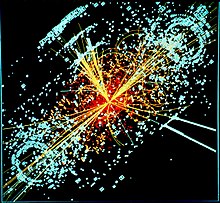Bósónì Higgs
| Àyọkà yìí únfẹ́ ìyílédèdà sí Yorùbá. Ẹ ran Wikipedia lọ́wọ́ ṣàtúnṣe sí ìyílédèdà |
 | |
| Composition: | Elementary particle |
| Status: | Tentatively observed – a boson "consistent with" the Higgs boson has been observed, but as of July 2012, scientists have not conclusively identified it as the Higgs boson.[1] |
| Symbol(s): | H0 |
| Discovered: | a compatible particle has been observed by ATLAS and CMS (2012) |
| Types: | 1 in the Standard Model; 5 or more in supersymmetric models |
| Mass: | 125.3±0.6 GeV/c2,[2] ∼126 GeV/c2[3] |
| Electric charge: | 0 |
| Spin: | 0 |
The Higgs boson or Higgs particle is a proposed elementary particle in the Standard Model of particle physics. The Higgs boson is named after Peter Higgs who, along with others, proposed the mechanism that suggested such a particle in 1964.[4][5][6] The existence of the Higgs boson and the associated Higgs field would be the simplest known method to explain why certain other elementary particles in the standard model have their mass. In this theory, an unseen field permeates space; this field has a non-zero value everywhere, even in its lowest energy state, and various other elementary particles obtain mass by interacting with this field. The Higgs boson—the smallest possible excitation of this field—is predicted to exist by the same theory, and has been the target of a long search in particle physics. One of the primary design goals of the Large Hadron Collider ("LHC") at CERN in Geneva, Switzerland—one of the most complicated scientific instruments ever built—was to test the existence of the Higgs boson and measure its properties, which would allow physicists to confirm this cornerstone of modern theory.
Because of its role in a fundamental property of elementary particles, the Higgs boson has been referred to as the "God particle" in popular culture, although virtually all scientists regard this as a hyperbole. According to the Standard Model, the Higgs particle is a boson, a type of particle that allows multiple identical particles to exist in the same place in the same quantum state. Furthermore, the model posits that the particle has no intrinsic spin, no electric charge, and no colour charge. It is also very unstable, decaying almost immediately after its creation. If the Higgs boson were shown not to exist, other "Higgsless" models would be considered.
By 2011 a number of these experiments had gradually and consistently highlighted a range of energies around 125 GeV (a unit of mass for particles). On 4 July 2012, the CMS and the ATLAS experimental teams at the Large Hadron Collider independently announced that they confirmed the formal discovery of a previously unknown boson of mass between 125–127 GeV, whose behaviour so far was "consistent with" a Higgs boson, noting that further data and analysis were needed before positively identifying the particle beyond doubt.

|
Àyọkà yìí tàbí apá rẹ̀ únfẹ́ àtúnṣe sí. Ẹ le fẹ̀ jù báyìí lọ tàbí kí ẹ ṣàtúnṣe rẹ̀ lọ́nà tí yíò mu kúnrẹ́rẹ́. Ẹ ran Wikipedia lọ́wọ́ láti fẹ̀ẹ́ jù báyìí lọ. |
Akiyesi
[àtúnṣe | àtúnṣe àmìọ̀rọ̀]- ↑ Note that such events also occur due to other processes. Detection involves a statistically significant excess of such events at specific energies.
Itokasi
[àtúnṣe | àtúnṣe àmìọ̀rọ̀]- ↑ Àṣìṣe ìtọ́kasí: Invalid
<ref>tag; no text was provided for refs namedcern1207 - ↑ Àṣìṣe ìtọ́kasí: Invalid
<ref>tag; no text was provided for refs namedcms1207 - ↑ Àṣìṣe ìtọ́kasí: Invalid
<ref>tag; no text was provided for refs namedatlas1207 - ↑ Higgs, Peter (1964). "Broken Symmetries and the Masses of Gauge Bosons". Physical Review Letters 13 (16): 508–509. Bibcode 1964PhRvL..13..508H. doi:10.1103/PhysRevLett.13.508. http://prl.aps.org/abstract/PRL/v13/i16/p508_1.
- ↑ Englert, François; Brout, Robert (1964). "Broken Symmetry and the Mass of Gauge Vector Mesons". Physical Review Letters 13 (9): 321–23. Bibcode 1964PhRvL..13..321E. doi:10.1103/PhysRevLett.13.321.
- ↑ Guralnik, Gerald; Hagen, C. R.; Kibble, T. W. B. (1964). "Global Conservation Laws and Massless Particles". Physical Review Letters 13 (20): 585–587. Bibcode 1964PhRvL..13..585G. doi:10.1103/PhysRevLett.13.585.
